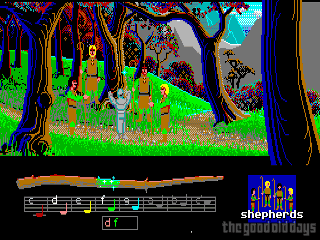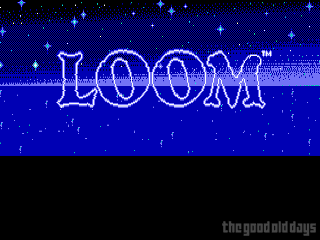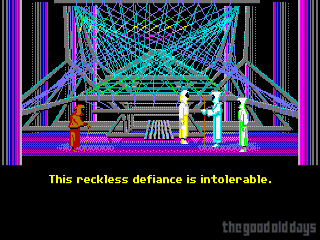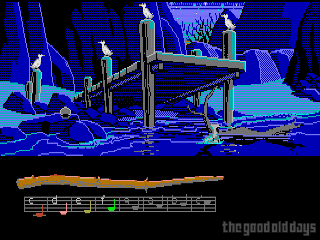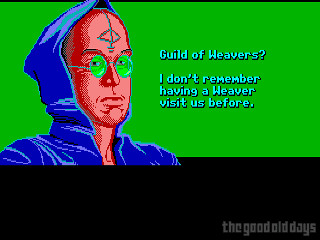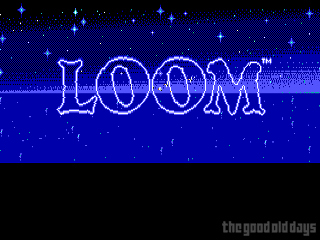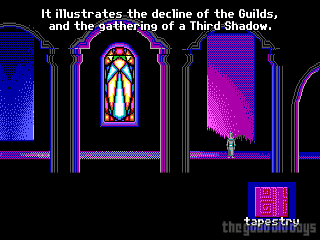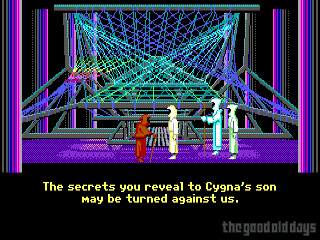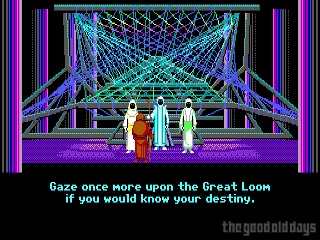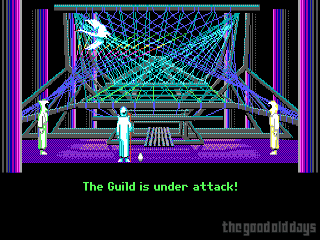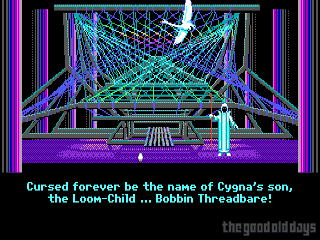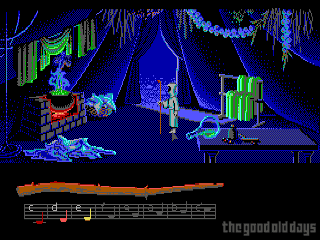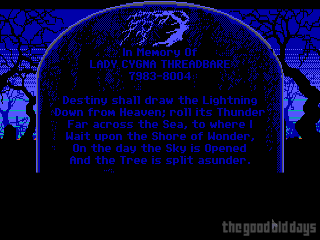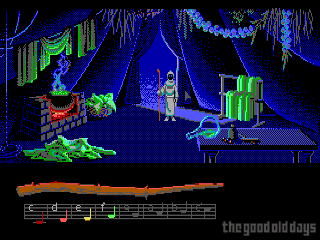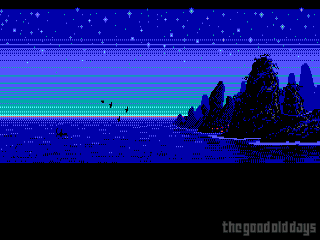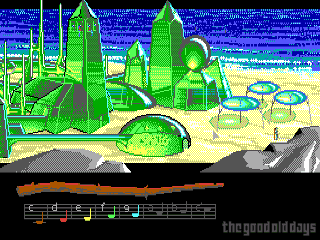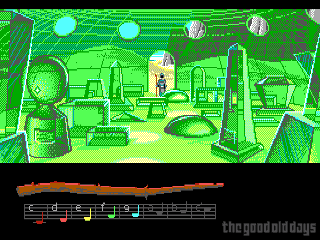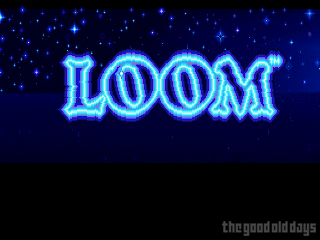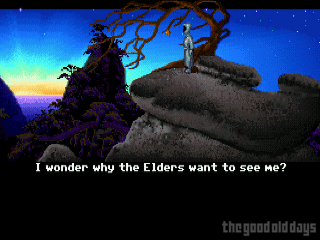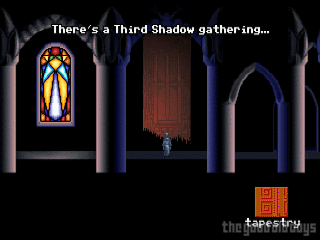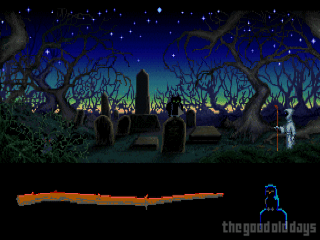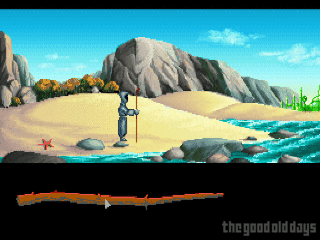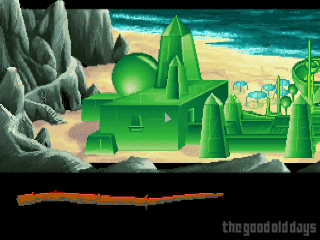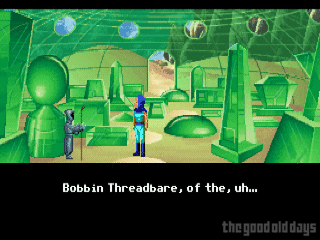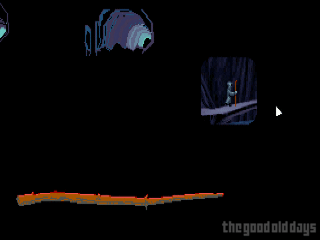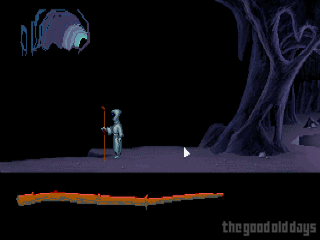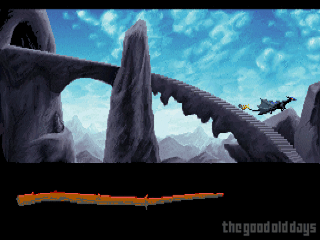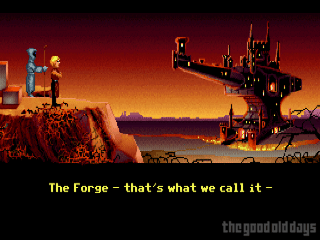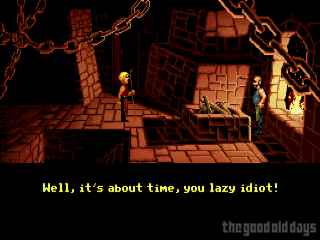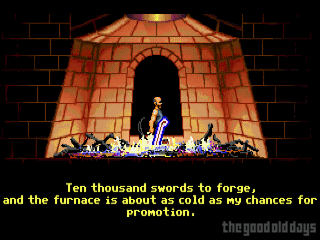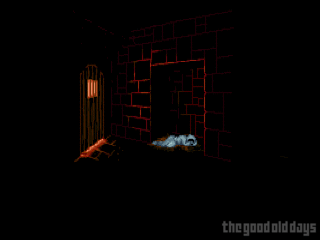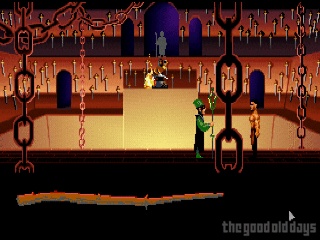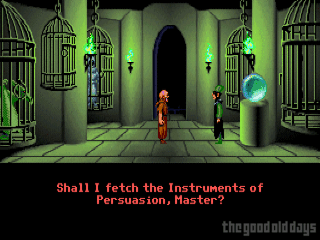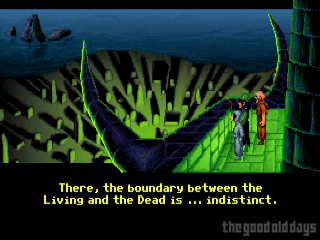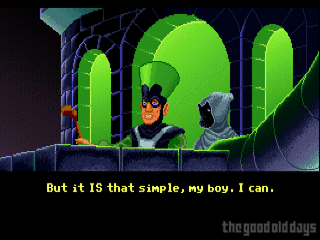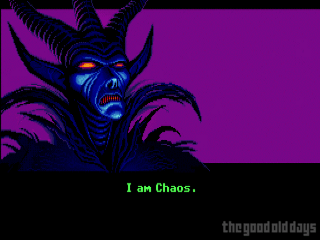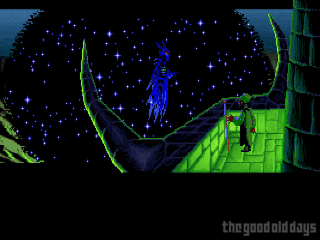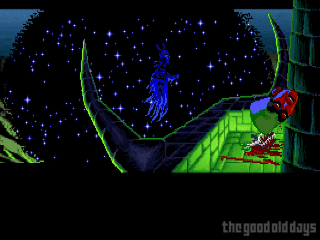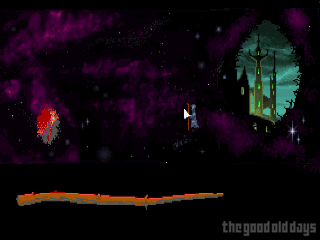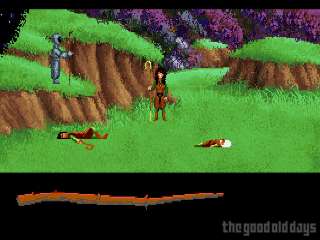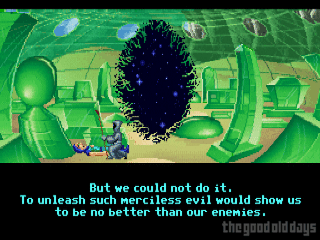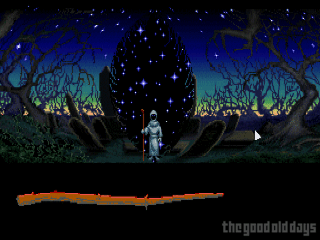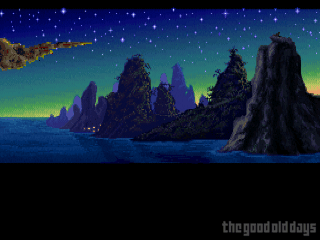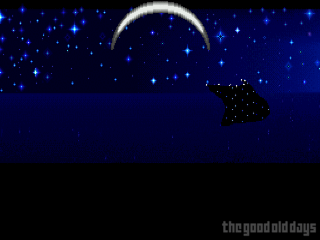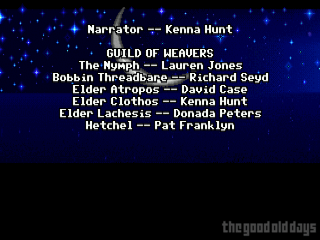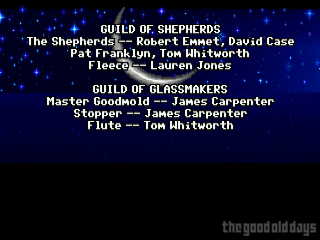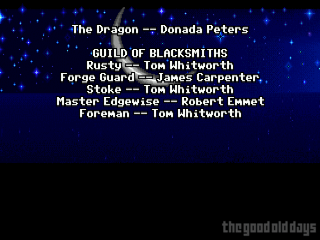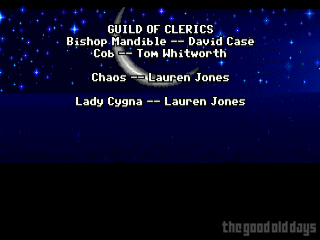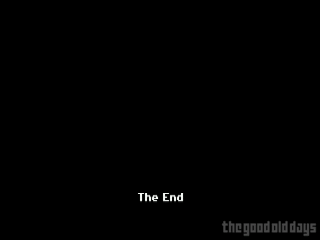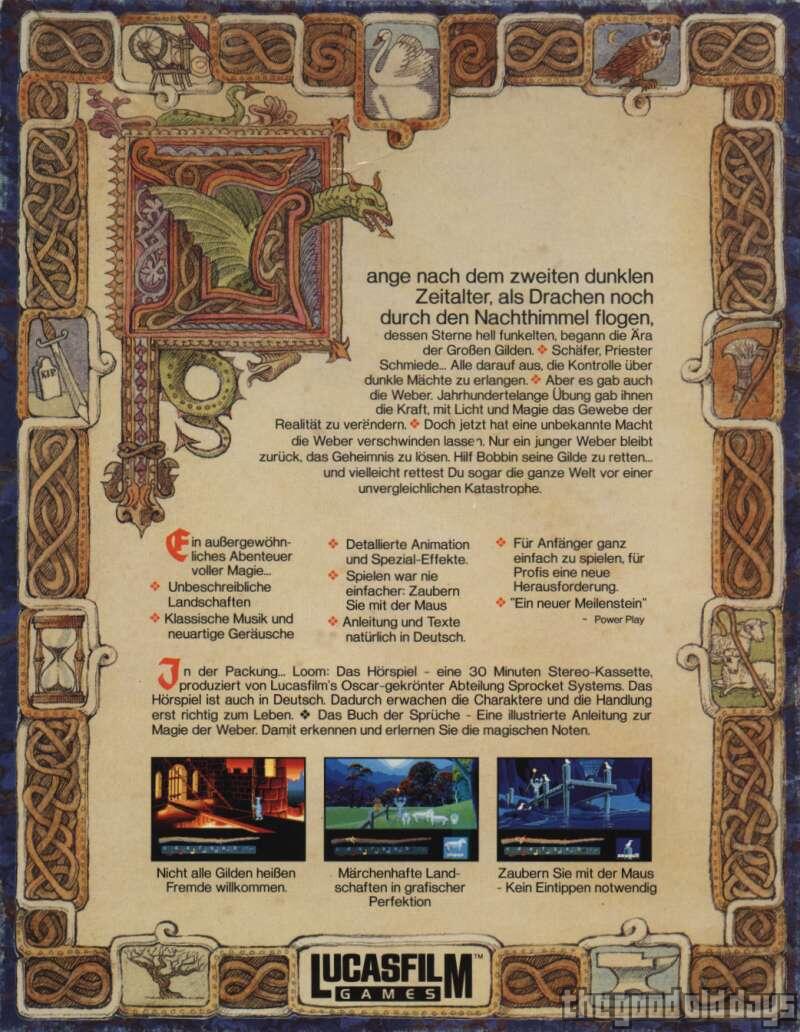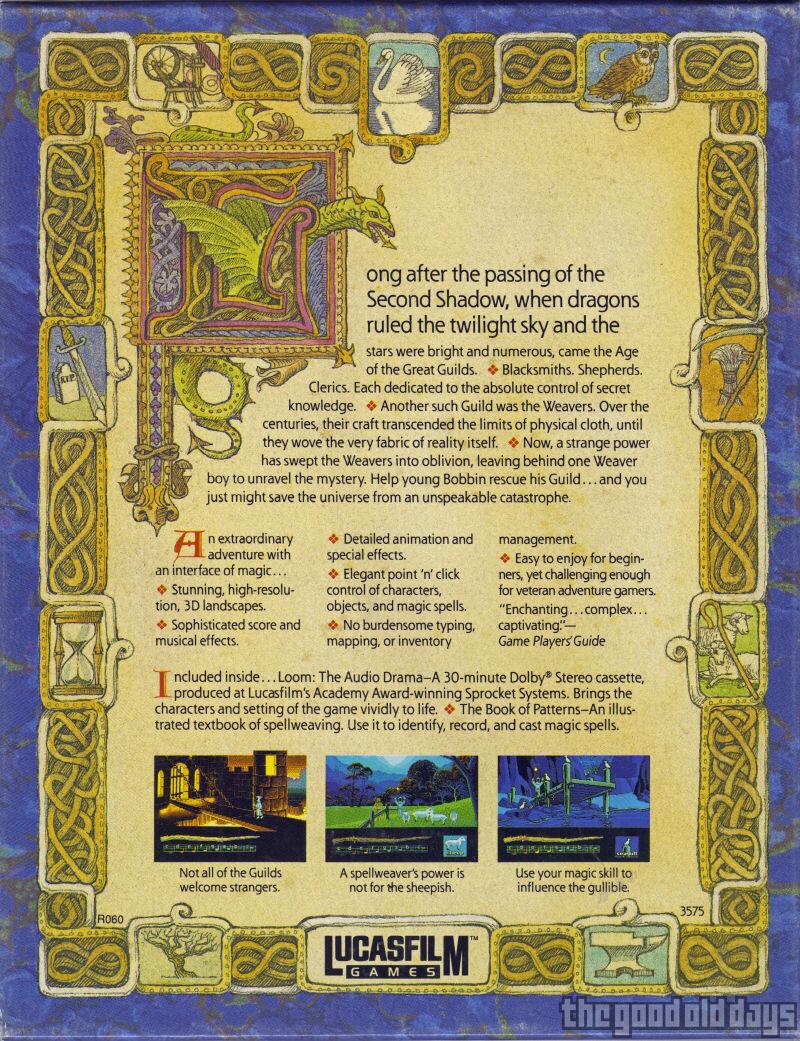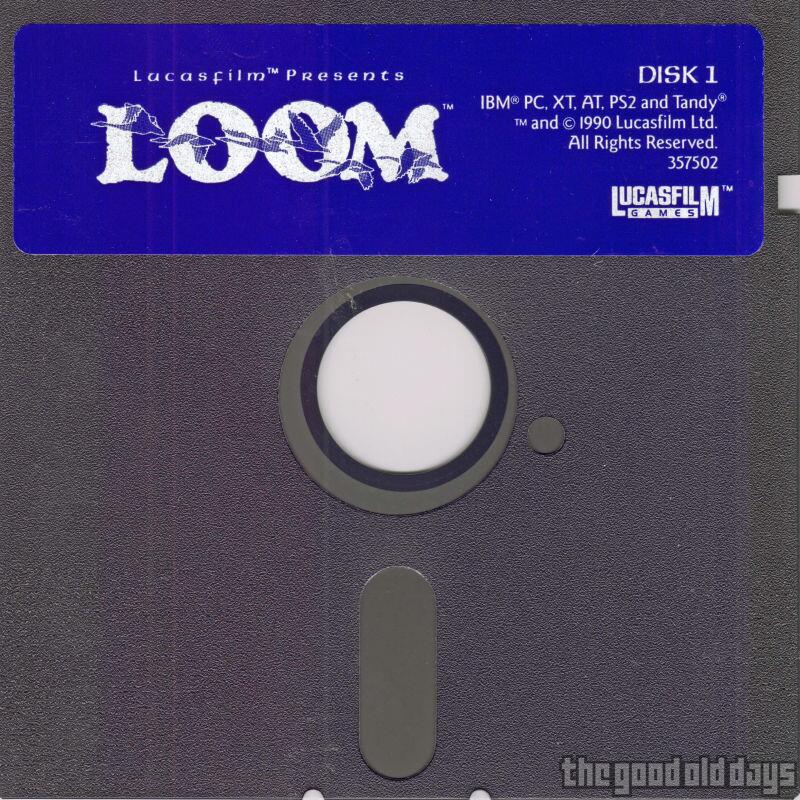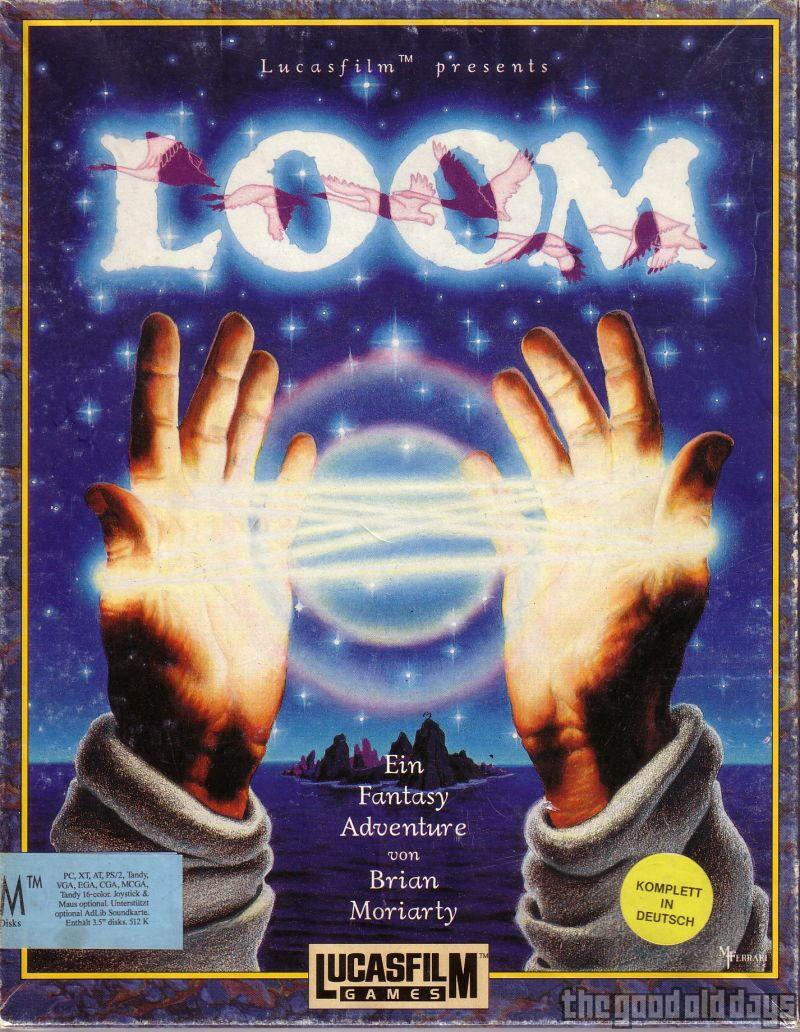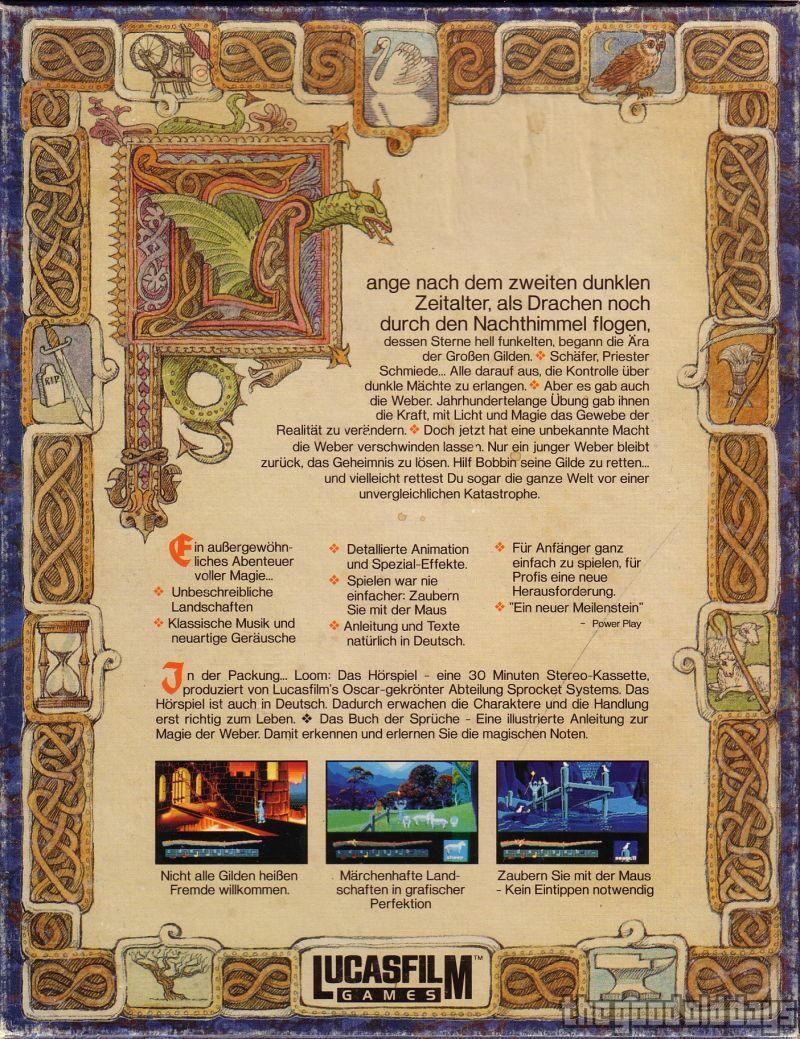Thoughts by Mr Creosote & Wandrell (29 00 2012) – PC (VGA)
[Mr Creosote] Loom is the brainchild of Brian Moriarty who got famous in the 1980 for designing a few Infocom games, in particular Trinity which to this very day is generally held in high regard due to its serious, very grim theme, made in a time when most games were still simple Tolkienesque treasure hunts. Loom remained Moriarty’s only (finished) foray into the world of graphic games, though.
[Wandrell] Which is a sad thing. As this game is no doubt a landmark on adventure games. It changed the way puzzles are handled using a clever trick, which at first may sound like a gimmick. Instead of verbs, you have magical melodies that let you interact with the world.
[Mr Creosote] So this is another highly original piece which deserves its place in the gaming history canon – even if it was not as influential as it should have been.
In 1992, Lucasfilm Games decided to release an “enhanced” version of the two-year-old game on CD. We will get into the changes later in this review.
Plot
Overview
[Wandrell] The story of Loom happens in an unnamed world, in the time of the Great Guilds, when the Third Shadow is approaching. The protagonist, Bobbin Threadbare, is a member of the Weavers guild. A pariah, as the elders seem to hate him, saying to the other kids he is a half-wit. But soon, on his seventeenth birthday, the day the game starts, he is going to find out what really is going on.
[Mr Creosote] Secretly, his foster mother Hetchel has been teaching the musical magic of the Weavers to him. As the game begins, Bobbin overhears the Elders holding trial over her for that. Then, something really strange happens…

[Wandrell] After the elders punish her with their magic, Hetchel turns into an egg. Something is wrong, the magical loom is not working as it should. And it becomes even more clear when a swan, breaking the glass window of the hall, enters the room, and the music of the recent spell, reverberating on the loom, transforms all the weavers into swans.
Part of this is explained by that fact that the weavers, hating violence, have transformed their most valued spell into their worst punishment. Forcing those whom they consider dangerous to transcend their existence, becoming magical swans.
[Mr Creosote] So Bobbin is now all alone on the Weaver’s island, utterly confused with what’s going on. So he begins a journey which will first take him to the lands of the other guilds and later to and beyond the layers of reality.
[Wandrell] And as he keeps going, in search of his guild, he keeps noticing something strange is going on, and that the world is spiralling, again, for a dark age.
Fantastic Elements
[Mr Creosote] So, this is pretty much “high fantasy”. You’ve got magic of all kinds, spiritual dimensions and epic battles of good versus evil.
[Wandrell] But “high fantasy” usually means “Lord of the Rings copy”. Here you have a strange world, were everybody has their own magic, related to their professions, and which looks more like the weird worlds of Jack Vance or Michael Moorcock than your typical fantasy world.

[Mr Creosote] Yes, this is no “lazy medieval”/Tolkienesque world, but a concisely built one which is original and therefore fascinating. Like Bobbin, the player has to figure out the rules of this world by himself. The exploration of the “magical” possibilities takes up most of the time.
[Wandrell] Another thing I like is how each guild sees the world according to their labor. Weavers talk about “the fabric of reality”, glassmakers “attain final clarity” when they die, and blacksmiths have a fiery and strong-willed way of seeing things.
[Mr Creosote] Let’s talk about these guilds some more. Although they are all based on classic professions as you said (weavers, glassmakers, blacksmiths,…), their whole societies have been built around those professions and there seems to be little interaction at least of the weavers with the others, their magic seems to be the same. I found this strange.
[Wandrell] At first, due to the audio drama, I understood that the weavers were the only to reach the skills to shape reality through magic. But then the book of patterns talks about spells that change hands, becoming the secret of one guild after another. And you even see one of the shepherds attempting to use musical magic at one point.
This is never made clear in any way. But ends looking as if they all somehow took the power from the same place. Just that the weavers are attuned to the patterns of magic and can “hear” them.

[Mr Creosote] In fact, Bobbin even learns some spells from the shepherds. Some of which work for them, some of which don’t. And one minor villain needs Bobbin to show him some extremely basic magic, too. Although, as we said, the shepherds (who are his allies at that point) seem to have much more advanced magic already. Even the eventual villain, a sort of devil/death incarnate called Chaos, uses exactly the same magic, even if it is channelled through an amulet rather than a staff.
[Wandrell] As said, it may just be that the weavers can sense that magic. Chaos probably just sees it happen, with no music. Also, it’s true that while the shepherds clearly are magical people, the glassmakers magic is all based on light and glass, and the blacksmiths never show any kind of magic, just hard work.
[Mr Creosote] Nevertheless, Bobbin can see/hear the effect of the blacksmith’s and glassmaker’s work in magical terms. I’d say this simplification to one kind of magic has gameplay reasons. Just like in Death Gate, where the protagonist’s magic is also similar to that of the “lesser races”, while in the novels, the kind of magic is fundamentally different. Having incompatible kinds of magic would not work well in a game, of course.
The Question of Scale
[Wandrell] I think that is one of those points where the game feels small. Too small scope for a world that could offer a lot more.
[Mr Creosote] This is also a very important point: The scale of things. At no point in the game did I really get the impression that these guilds are real “tribes”. The weavers seem to only consist of the elders, Hetchel and Bobbin. There is no room for anyone else in their village. Even the glass city which looks so impressive from the outside can be walked through in just three screens.
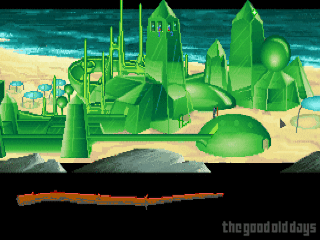
[Wandrell] Well, the audio drama says the guild is dying. Most of the children are born dead, those who aren’t are usually are deformed. Still, they say there are other kids around. But I suppose the trascendence spell transformed all the guild into swans, not just the elders.
Still, it’s true that the other guilds do not give the feeling of being true city states, some even able to buy their own armies, as they are supposed to be. The background given along the game doesn’t match what is shown. But sadly, this is surely an effect of LucasArts lacking enough manpower for a bigger game, because their other games are more fleshed out.
[Mr Creosote] At the very least, the weavers should have a bigger city if they once were more numerous. It just seems to be four or five tents, though. And when Bobbin leaves the island, the swans accompany him – all six of them! It is also never made clear how the guilds survive and what they actually do. With the shepherds, it’s easy to see how they would live. But what about the blacksmiths and the glassmakers? Do they import food from the shepherds? If so, how do they pay for it? It does not seem that the shepherds, who are really the only ones producing any kind of food, would have any use for glass or iron products. Their huts are made of wood and they don’t have any windows. So before Bishop Mandible came along with his large order of swords, what did the blacksmiths do all day?
[Wandrell] Well, the idea of having guilds, in real life, goes along with having big cities. But as we said, each guild has its own city, no kind of “unaligned” settlement is ever seen. But maybe there is a traders guild? Handling all the buying and selling themselves? I don’t think that in a world like this that kind of logic would go far, anyway. There are just the guilds, trying to achieve perfection in their trades.
[Mr Creosote] Sure, there could be explanations, but they aren’t in the game. This actually bothered me in my latest playthrough: The guilds seem to be too focused on their function, there is too little information about their daily life. Coming back to lack of scale, there is an invasion of the dead later in the game – but you never get to see that, either! You simply visit the locations you already know, see some effects and talk to some people who tell you about it. This violates the first rule of storytelling: show, don’t tell.
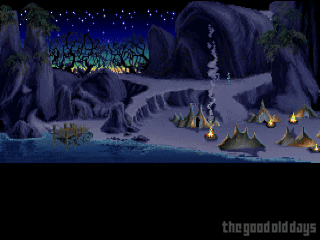
[Wandrell] I fear this is probably due to lack of space, which wasn’t anything new. After all, there are for example unused graphics for the glass city, which hint at more rooms, and a test screen for the rift of the graveyard, showing the dead fleeing. Again, I suppose they preferred to expend time and manpower with Monkey Island, which looked easier to sell, and had to cut this game down.
Also, there are cut down pieces of dialogue on the CD version hinting at the origin of the healing song as something they did learn from another guild (I think this was on the original). Which would explain the similarity on this magic.
[Mr Creosote] So I’d say the basics of this world and story are excellent. This is exactly the kind of “mature fantasy” which could appeal to people beyond their teenage years. However, it remains a bit too shallow, too many questions are left unanswered (and not on purpose to create a mystery) and there are various missed opportunities to really show the epic scale of this plot. It’s a bit as if Lord of the Rings did not have the large scale battles with the Orcs etc.
Themes
[Mr Creosote] The maturity shows in many ways. One is the play on the Bobbin character which the player first assumes to be a typical saviour character, but that theme is given a beautiful and surprising twist at the end. It also shows in the subconscious themes of the plot. For example, the glassmakers and their “ultimate” weapon (clearly an allusion to the nuclear arsenals of our day) which, when the time has come, they refuse to use after all.
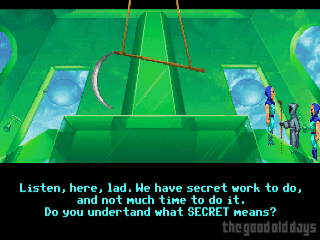
[Wandrell] It would be an immoral act, one that would lower them to the level of their enemies, they say. Still, it’s never clear what is the exact power of that weapon, apart from scaring the enemy with a risk of retaliation.
[Mr Creosote] How the weapon would work technically is of little consequence, in my opinion, it’s just a fantasy-compatible rendition of a weapon to end all wars. It’s just clear that it would have stopped the invasion of Chaos' army, but at a price the glassmakers were finally not willing to pay. They rather died what they considered an honourable death. Not what is called a “honourable death” by typical Hollywood standards (‘fair battle’ and all that crap), but rather in Gandhi’s. This certainly is a strong statement and much more so in the late 1980s when this game was made.
[Wandrell] I suppose each guild is supposed to have it’s own thing. The weavers after all have the Moiras as the elders (even if not all of them are female). And the Loom, which represents the world, and so can shape it, is changed when a single grey strand, and so one without any clear future, is added to all the colored ones, sending the world into an unpredictable future.
Fate is a stereotypical topic in lots of stories, but in this case I think it was handled well in a way that extends into all the game, with the gray way of acting of Bobbin, up to the Pyrrhic victory of the end.

[Mr Creosote] Exactly. Then, there is the aspect of the post-apocalyptic world or maybe even a circular history repeating itself over and over again. It is hinted at several points that the world of Loom might be our own, just after various apocalypses which destroyed societies as they were previously known to make room for a completely new world. In game terms, these are “the shadows” – it’s a bit like the Aztec mythology where the end of each cycle in their calendar would indicate a fundamental change in the world.
[Wandrell] The ages being represented by the suns? Each being destroyed by catastrophe, that is followed by a new sun being born. It’s never clear what the shadows are, even when Chaos says she (I think it’s “he” on the floppy version) was here before it’s not clear what she means, it just may be that Chaos is active always during the dark ages of the world. But I always thought that at least the first shadow refers to a nuclear war.
[Mr Creosote] Which makes large-scale (nuclear) war a recurring theme in Moriarty’s games: Trinity was all about that and in Loom, it shows its ugly head yet again as the incarnation of complete and utter destruction of everything.
The Role of Music
[Wandrell] As commented before, in this fantasy world you won’t find the epic of Tolkien books. And the lack of epic-ness is, in a way, ironic. Because this game could be described as a videogame opera. I may not know much of opera, but the bigger than life plot, mixed with magic, and above all the importance of music surely make me think of it. Because music is what shapes the world to the player on this game, and also what helps to give it such a great atmosphere.
[Mr Creosote] The main musical themes have been taken from Tchaikovsky’s Swan Lake and indeed, they have been integrated into the plot and even the gameplay perfectly.

[Wandrell] If I’m not mistaken, the Swan Lake ballet revolves about a beautiful woman that became a swan, and only once a year transforms back into her real shape. And one of the characters in Loom is a beautiful woman who has been transformed into a swan, and only once a year comes back to see her son. So the reference to the ballet is clear and, maybe, I don’t know, there are others around.
[Mr Creosote] At the very least, the music makes for a haunting background, even for those who have no background on Swan Lake. Just that there also isn’t enough it it: It seems to be only used in cutscenes.
This makes for various missed opportunities. For example, when first entering the blacksmith’s city, there are incredibly beautiful silhouettes and shadows of blacksmiths at work, swinging their hammers, hitting of metal on metal. What could be more rhythmic than that? Perfect opportunity to sneak in some music which matches the visuals. Yet, the game remains silent.
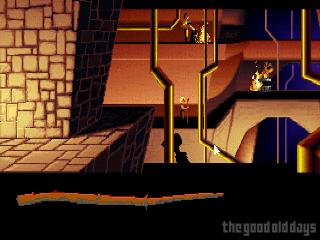
[Wandrell] It’s true that most of the game is silent. Not even the Redbook audio of the game could solve this. Still, I must say that I didn’t like the music improvement on this version. It sometimes sounded better, but in other scenes not so much. They could sound cleaner, but I think this was a problem with CD games back then in general. Still, it can become a problem when it gets into the magic puzzles, as the notes were much clearer in the original game.
[Mr Creosote] I can’t say I have any complaints about the technical quality of the music or its inclusion into the gameplay. Which, by the way, we should at least quickly recap (although it is described in more detail in other reviews of Loom here on the site).
Gameplay
[Wandrell] As said, the game offers what at first looks like a gimmick. There are no verbs, there is no inventory. Instead, there is magic, which handles all the interaction your character will have with the world.
[Mr Creosote] To achieve any effect on the world, Bobbin (i.e. the player) has to first learn magic spells, many of which represent what would be the classic verbs in a typical adventure: open/close, twist, empty, light, sharpen and so on.

[Wandrell] The thing is that some spells can be reversed. In general, if the first and last of the four notes are different, you can play it in reverse order to generate the contrary effect. So reversing the open spell creates the close spell, for example.
[Mr Creosote] In musical terms, each spell consists of four notes (within the range of one octave). So, for example, “open” might be “e-c-e-d”, and “close” is “d-e-c-e”. Apart from this first spell, the notes are randomised each time you start the game, so you need to take notes while you’re playing; no walkthrough can possible help you in this regard.
[Wandrell] It should be noted that there are three different difficulty levels. Each offering more or less help. In the hardest setting, you will have to play mostly by ear. I always play on this, as it gives a secret scene in the later part of the game, and makes the game more challenging.
[Mr Creosote] Still, even the “expert” difficulty level is really not all that hard. All musical notes are always also accompanied by a distinct colour flashing, so even people who are basically tone-deaf should only have few problems.
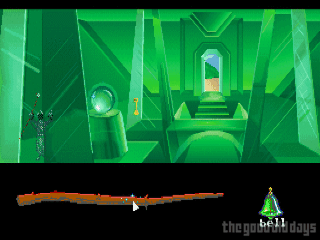
[Wandrell] Not always. Right now I’m not sure if in the floppy version the distaff shows the colors of the notes when hearing spells even in the hardest setting. But I can assure that there are some spells in the CD version which show not even the color, just the tones.
[Mr Creosote] In any case, we are talking about a series of four tones within the range of one octave, without the tones blending into one another and without the use of semitones. This is hardly rocket science. In game terms, what is interesting that by using magic, Bobbin’s skill level increases, enabling him to hit higher notes and therefore weave additional spells in the course of the game.
[Wandrell] Sadly this tends to be on clear points of the game. So mostly it serves to tell you a spell you recently did learn, but lacked a tone for it, will be used soon.
[Mr Creosote] What is interesting about this is that sometimes, you will hear spells, but you cannot immediately reproduce them in-game. In these cases, a piano or simple keyboard sure comes in handy.
[Wandrell] Not as handy as a notebook or similar. As said, there is no inventory or anything similar, so any spell you learn will depend on your memory. Forget it and you will end getting stuck. Luckily there are a few puzzles which can be solved using more than one spell.
[Mr Creosote] All of this makes Loom a very easy game: Spells are usually used shortly after they have been introduced and the interaction is always one-dimensional, i.e. Bobbin applies a spell to a scenery object. It never gets more complex, the focus is obviously much more on the plot than on the gameplay – even if the latter is a novel concept which, to my knowledge, has never been used again.
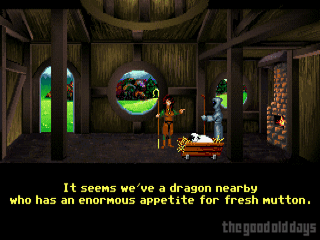
[Wandrell] One thing I think could be improved are the dialogues. LucasArts used to give interactive dialogue, but on this one they are all automatic. Interact with a person, and they speak their scripted lines.
[Mr Creosote] This is Moriarty at his best. The guy is known as a total control freak and he probably couldn’t have accepted any deviation in the progress of the plot. This went as far as him actually listening to the non-English versions of the included “audio drama” and criticising the intonation of the voice artists – even though he did not even understand the language and had no clue about typical voice patterns of the respective language.
[Wandrell] That’s always a problem. A game must offer freedom to the player. Also, I think that this lack of real conversation was a thing criticised when the game was published. And something that could have improved it.
CD Enhancements
[Wandrell] This review is not just about Loom. We played the CD-ROM version, the enhanced talky Loom version for PC, which added VGA graphics and voices to the dialogue. But for adding all this, some sacrifices had to be done.
[Mr Creosote] So let’s go step by step. The graphics use more colours, 256 instead of the original 16. This really makes for some gorgeous scenery, since Loom was indeed one of the first games to use hand-painted backgrounds. It’s not really a complete conversion to the larger colour scale, though. Bobbin’s staff, shown in the bottom part of the screen, is still present in all its 16-colour-glory. Similarly, many animations have not been redone, e.g. the transparency effects in the glass city and some light effects.
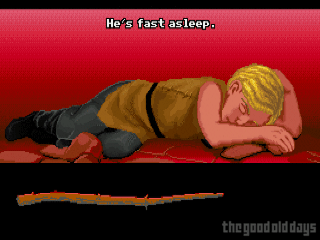
[Wandrell] In general, everything in the lower screen keeps the old graphics, including the icons when selecting an object. But also some of the graphics are missing, most noticeably the smoke when the the distaff is in the fire, or the dragon extending her claw to the blacksmith kid. And, worst of all, the secret scene has been reduced to a weird green flash.
[Mr Creosote] The latter is indeed quite a blow: First, they put in an additional scene in the original as a reward for players selecting the highest difficulty setting, but then they shorten it again in this version. Also, some closeups which were shown in the floppy version during the dialogues seem to be missing.
[Wandrell] In general they did a lot of cuts. Including the dialogue lines, which were shortened to fit the limited time of sound the CD allowed.
[Mr Creosote] Which leads us to the newly added voices. This was the time before compressed audio became feasible, hence the dialogue cuts. But at least that cut down variant of the lines can now be listened to. Interestingly enough, all voice actors seem to be British – the weavers and the Bishop are very posh Englishmen, the shepherds are Scottish and so on.
[Wandrell] Are you sure they are Scottish and not faking? It’s actually possible to understand what they are saying. Anyway, the voice actors, those for the weavers I mean, seem to be the same as in the audio drama, which is a nice touch.

[Mr Creosote] I’m certainly not able to tell a real accent from a faked one in the English language, so let’s just say that the accents are supposed to be British. Which is still strange enough in an American game. I wonder why they did that.
[Wandrell] Probably it was a good and cheap studio. And as they used them for the audio drama they thought it would be a good idea reusing the same studio. Sadly, I can’t find the name of the studio right now to check if they were actually British or not.
[Mr Creosote] On this note, let’s quickly talk about the “audio drama” which we have already mentioned a few times. This is not a difference between the original and the CD version. It sure would have been nice to have the audio tape included on the game CD, but… space restrictions. Anyway, I thought this was a nice “feelie”, again in the tradition of Infocom, but the production was only solid. I used to listen to a lot of standalone audio dramas in my childhood (on actual records… most of our readers probably don’t even know what that is anymore) and most of them had higher production values and better voice actors than this. As I said, solid, but it didn’t blow me away.
[Wandrell] Well, I used to listen to cassettes with kid stories as a kid, if that counts. But those things are more of the radio days. Still, I think it’s a great feelie, a short introduction to the game.
Conclusion
[Wandrell] But now we are getting to the end of the review, and I must say that Loom is one of my favorite games. Short and good. But this CD version actually didn’t improve anything. Better graphics, usually, but cut content. Not a good exchange.
[Mr Creosote] I’d say this version suffers from the same problems the game was always plagued with: It’s so beautiful, now even more so due to the improved graphics, and not just visually, but the complete experience from music to plot and characters (as few of them as you meet). Yet, it only barely scratches the surface – there is so much more potential in these themes, many of which we have touched upon in this discussion.
[Wandrell] I wish they would have made the sequels they talked about. But it never went much further that saying Rusty Nailbender and Fleece would be the main characters in each.

[Mr Creosote] I said it before, but putting a positive spin to it, Brian Moriarty is a perfectionist. It’s strange that he was satisfied with the game as it is. As good as it is, it’s far from perfect. It works very well as an “interactive story” – it’s not much of a game. This is a direction which is only explored in amateur/indie games these days. Kind of a pity, because Loom is truly groundbreaking in this respect. It’s great and frustrating at the same time: It teases us with what it could have been, but at the same time, it is already very good.
[Wandrell] So in the end. Short and nice, but will leave you wishing more.
[Mr Creosote] And if, after reading this discussion, you believe this can’t really be a good game, because we’ve been listing downsides most of the time, consider this: What kind of game is even worth discussing in such detail? Only a very good one.
As for versions, Mr. Moriarty himself does not consider this version the best one. He has given his “official” blessing to the one released on the Japanese FM Towns. That one has 256 colour graphics, but no cuts to the contents. No voices, though. I can see his point. Not that I wouldn’t recommend this IBM PC CD version as well.


